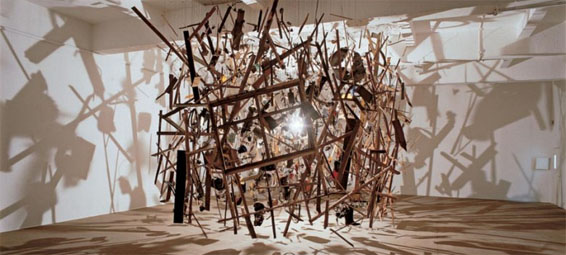Over on Glasstire, a couple of familiar names, Lucia Simek and the great Dutch artist/philosopher Toojerstraap, use the summer heat as an excuse to hash out the problem with Dallas art and artists. In short, we live in a city that has too much space and not enough compression. Compression creates tension and tension creates art.
“The hardest thing about being here,” Toojerstraap writes, “is creating a space to act out within and then defining a format.“
(Sidenote: Lucia has obviously translated the Dutchman’s usual indecipherably broken English and removed some of the expletives as well. For a taste of the full uncensored ‘straap, check out the conversation that broke out in the comments of this FrontRow post between the Dutchman and another shadowy Dallas art world figure, the erudite Frenchwoman, Marianne Laflange.)
There is, of course, the problem of physical space. The lack of proximity and frequent interaction of artists and thinking folk in general creates a city whose intellectual class exists as a long archipelago. There is occasional cohesion, and sometimes, as was the case with the Modern Ruin exhibition last year, actual action. But sustaining any activity or social effort is very difficult.
Geographic space is just one issue, there is also psychological and cyber space to contend with. Again, van Toojerstraap:
”Arguably, in fact,” Toojerstraap said on this topic, “ the idea that Dallas might even be suffering this delusion of having/getting art, or that it can, or does, even have its own micro-art world, is a manifestation of the new ‘too much space’ world of the internet where aesthetics, philosophy etc. have no real consequence because they remain untethered to the convergence of a particular time, place and identifiable set of individuals. In effect… we have all turned ourselves into machines. Art has simply become information. Which to the collectors is of no real concern, since everything and nothing is leverageable so long as you can give it a name or a number.”
Lucia then shares her own recent experience of working on a public art project that brought to the table various representatives form Dallas’ multiple art “worlds.” We don’t talk about this too often, but the local art community is a wildly segregated bunch, with various individuals falling under such contrived subcategories as “local art world,” “activist art world,” “over-emotive, interior designee smooth jazz rich guy art world,” “the real art world,” etc. etc.
Perhaps some of those divides, Lucia proposes, are more a function of the rifts in Dallas’ abundant cultural space and not so much insurmountable divisions of quality, taste, style, or ideology. From Lucia:
I have lately, though, had the pleasure of sitting on a public art committee with a group of artists from various camps, all at the same table carving out a project we collectively believe in. Through discussion and sometimes real vehemence, we’ve tackled what I had begun to believe was an a tremendously vast chasm between different ways of thinking about art and all its facets. The friction, I think, around that table has shaped a much more dynamic project than would have been made among like-minded fellows. It’s been a real lesson to me in the power of compression – that activating tension that thumps out a reverb, change, into a too quiet city.
The problem, in many ways, remains politeness. We are too eager to let ideas go unchecked, debates un-debated. Too many striving individuals merely receive a momentary pat on the back and a quick forgetting. Toojerstraap concludes the exchange:
”If Dallas is truly upping the ante with its arts district on a national stage, etc – but it’s essentially a bit crap and lifeless – then we – as artists/writers, etc – we have to provide the life somehow or other. . . .Politeness doesn’t really come into it. In fact, there’s no need for politeness, because the doorway we’re all about to collectively step through is to an unoccupied room, so no one will care if we’re all buck naked.”
Image: Cornelia Parker, Cold Dark Matter: An Exploded View (1991)






